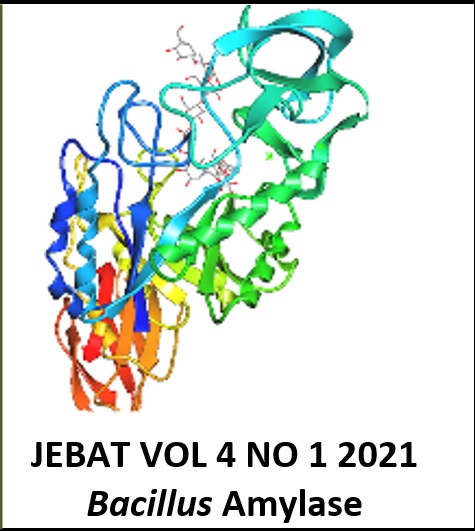Preliminary Investigation of Amylase Producing-Bacteria from Soil in Gombe Metropolis
DOI:
https://doi.org/10.54987/jebat.v4i1.576Keywords:
amylase enzyme; bacterial isolates; starch agar; screening; biochemical testsAbstract
Amylases are enzymes that are able to hydrolyse starch or glycogen molecules into polymers of glucose units. They have great potential applications in various industrial processes like in pharmaceutical, fermentation and food industries. Research on starch degrading enzymes has resulted into increased applications of amylases in different industrial processes. These enzymes occupy a greater space in the current biotechnological processes such as detergent, starch degradation, pharmaceutical, foodstuff, textile, and paper manufacturing. In fact, amylases constitute nearly 25% of the total sale of global enzymes. Amylases have been screened and identified from various sources, both eukaryotic and prokaryotic organisms such as animals, plants, fungi and bacteria, respectively. To further isolate novel amylases with enhanced desirable properties for such diverse industrial application, more organisms need to be screened. In this study, a total of 27 bacterial isolates were isolated from soil samples in Gombe metropolis. The bacteria were screened for amylase production using plate screening method. Each isolate was streaked onto a 1% starch agar plate and incubated for 24h at 37 °C. The plates were covered with iodine solution and observed for positive amylase isolates based on the formation of clearing zones against the blue black background. The results confirmed eight (8) isolates of amylase-producing bacteria which include Bacillus subtilis, Escherichia coli, Streptococcus spp., Salmonella spp., Pseudomonas spp., Serratia spp., Proteus vulgaris, and Klebsiella spp. In conclusion, bacterial isolates capable of amylase production have been successfully screened and identified. This research may serve as a stepping stone to isolating functional amylase enzymes from these bacteria for promising industrial applications.
Downloads
Published
How to Cite
Issue
Section
License
Authors who publish with this journal agree to the following terms:
- Authors retain copyright and grant the journal right of first publication with the work simultaneously licensed under a Creative Commons Attribution License (http://creativecommons.org/licenses/by/4.0) that allows others to share the work with an acknowledgement of the work's authorship and initial publication in this journal.
- Authors are able to enter into separate, additional contractual arrangements for the non-exclusive distribution of the journal's published version of the work (e.g., post it to an institutional repository or publish it in a book), with an acknowledgement of its initial publication in this journal.
- Authors are permitted and encouraged to post their work online (e.g., in institutional repositories or on their website) prior to and during the submission process, as it can lead to productive exchanges, as well as earlier and greater citation of published work (See The Effect of Open Access).

